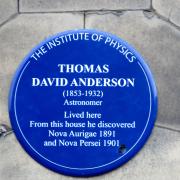
The Institute of Physics in Scotland (Iops) has honoured the achievements of a well-to-do amateur astronomer, Thomas David Anderson, with a blue plaque outside his former home at 21 East Claremont Street.
A ceremony was conducted at the address yesterday.
Anderson was born at 28 Saxe-Coburg Place on 6 February 1853. Five years later, his father – a wealthy director of the George Street upholsterers Robert Grieve & Co – took him to the front door to observe Donati’s comet in the south-western sky: ‘As he pointed out the great marvel above the top of the tree that stood before our house in Saxe-Coburg Place, he said to me that however long I might live I should never again behold anything so wonderful. So far as comets are concerned, he was right, I fancy.’

Graduating in the Classics from Edinburgh University in 1874, he went on to study at the Scottish Congregational College with the intention of eventually entering the Ministry. His shyness discouraged him from so public a career, as may have the not-altogether-useful subject of his doctoral thesis: Latin conjunctions. Instead, he concentrated on occasional sermon writing and star gazing. Much to his own surprise, one evening in late January 1892, he threw open a window at 21 East Claremont Street, stuck a pocket telescope to his eye, and spotted a previously unknown exploding star – Nova Aurigae – at the end of it.

... throwing a last glance upward, he suddenly saw a brilliant star in the constellation Perseus. His first feeling was actually one of disappointment, for he felt sure that this object must have been there for some time past without his knowing of it, and he grudged the time lost when he might have been regarding it. More in a spirit of complaint than enquiry, he made his way next day to the Royal Observatory at Edinburgh to hear what they had to say about it, though he found it difficult to approach the subject. He first talked about the weather and the crops and similar topics of general interest; and only after some time dared he venture a casual reference to the 'new portent in the heavens.' Seeing his interlocutor look somewhat blank, he ventured a little further and made a direct reference to the new star in Perseus; and then found to his astonishment, as also to his great delight, that he was the first to bring news of it.
Further important discoveries followed, particularly in 1918 and 1923, which will naturally be of no interest to Spurtle readers since they were made outwith Broughton. (Those wishing to know more should link to the Astronomical Society of Edinburgh, which article has formed the basis of this one.)
By the time of his death on 31 March 1932, Anderson had discovered a total of 3 temporary and 53 variable stars, many of which are still there.
-----------------------
Starlight, limelight, electric light, no light ... in that order: http://www.broughtonspurtle.org.uk/news/blue-plaque-local-watcher-skies … #history #astronomy
@theSpurtle awesome!
 Brian Ford @bfford 6 hours ago
Brian Ford @bfford 6 hours ago
@theSpurtle @auntyemily never knew the history at 21 East Claremont Street and I lived there on the 2nd floor

